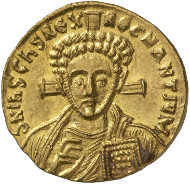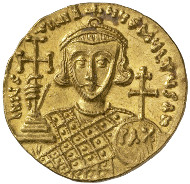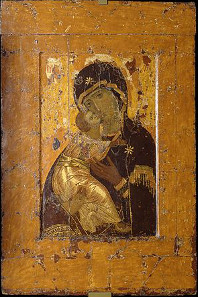with the kind permission of the MoneyMuseum, Zurich
Why is it that for centuries – or rather thousands of years – the head has served as the motif for the side of a coin? And why has this changed in the last 200 years? Ursula Kampmann poses these questions in her book ‘MenschenGesichter,’ from which the texts for our new series are taken.
Byzantine Times. Justinian II, 2nd reign (705-711). Solidus, Constantinople. Facing bust of Christ with nimbus, raising right hand in benediction and holding book of gospels in left. Rev. Crowned facing bust of Justinian, holding cross potent on three steps in right hand and patriarchal globe inscribed with ‘PAX’ (Lat. peace) in left. © MoneyMuseum, Zürich.
Justinian II acceded to the throne of the Byzantine Empire in 685 – being just 16 years of age, he faced seemingly unsolvable problems: in the East were the Arabs, in the North the Bulgars, and at home there were his officials scheming. How could the powerless emperor impose his authority? He referred to a higher authority and got himself praised as the man God had predestined to rule. Justinian found himself an ideal symbol for that: he – as the first ruler ever – had Christ, God’s Son on earth, depicted on his coins. He borrowed an icon that every inhabitant of Constantinople knew quite well: blessing Christ of the great city gate.
Divine help wasn’t enough, though. In 695, Leontios, strategos of Hellas, rioted. He was successful and sent Justinian into exile, after having slashed open the latter’s nose and tongue. But success eluded Leontios as well and so another emperor seized power.
By that time, Justinian had managed to escape from exile. He allied with his former enemies, the Bulgars, and – thanks to their help – rose to power a second time, but reigned for the duration of six years only. In 711, the emperor was dethroned again and executed together with his son.
In the aftermath of iconoclasm, iconic art began to flourish in the Orthodox Church. A case in point is one of the most important icons of Russian Orthodoxy, the icon of
‘Theotokos of Vladimir’, made probably in Constantinople in the 12th century. Source: Wikicommons.
Not only Justinian fell into disgrace but his numismatic subject also. The depiction of Christ disappeared from the coins. Some people considered the depiction of the divine outright sacrilege. The fight against the Arabs called for an examination of their teachings and so the commandment ‘Thou shalt not make unto thee any graven image’ (Ex. 20, 4) gained in importance again. That commandment being violated was regarded by many as reason why God didn’t protect his empire anymore. When a volcano erupted on the island of Crete, Emperor Leo II used that as an opportunity to put his own opinions into political action: the icon of Christ at the city gate, model for the coins of Justinian, was replaced by a cross. In doing so, Leo prompted the so-called Byzantine Iconoclasm that was to last for centuries in the East. It revolved around issues like: does the representation of a Saint also reflect his virtues? Or: does it qualify as wrongdoing when the divine is reduced to a depiction? The controversy only came to an end as late as the middle of the 9th century. The icon started its triumph in the Orthodox Church and the depiction of Christ returned to the Byzantine coins.
Next time on ‘Human Faces‘: how Frederick II from Apulia became Holy Roman Emperor.
All sections of the series can be found here.
The book ‘MenschenGesichter’ is available in printed form from the Conzett Verlag website. It soon will be translated to English …








